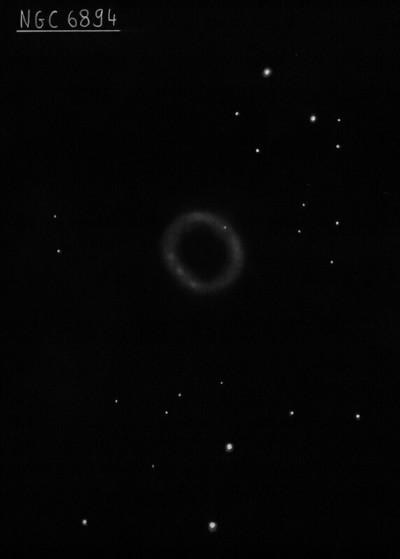
William Herschel discovered NGC 6894 = H IV-13 = h2072 on 17 Jul 1784 (sweep 239) and recorded "pF, exactly R, of equal light throughout. I believe it is resolvable, but am not certain, about 1' in diameter." He published a sketch in his 1811 paper (Fig. 33) as an illlustration of "nebulae that are of an almost uniform light."
John Herschel made several observations. On 4 Sep 1825 (sweep 7), he logged "planetary nebula; diam [by inexperienced estimation] = 1'; light equable; exactly round; vF, a mere ghost." On 1 Aug 1829, he recorded "eF; annular; pretty sharply defined; a very little elliptic; the northern limb is the brightest; the darkness in the middle requires some attention to see; but once seen it cannot be mistaken. A most curious object, resembling much the annular nebula in Lyra, but rounder, small (not above half the diameter) and far fainter."
LdR (or assistants) also described NGC 6894 as "annular" on 23 Aug 1851 (first observed on Aug 1 1848): "fine annular nebula like that in Lyra, R, the dark space is E pf, star easily seen in np edge and others suspected."
Based on Crossley photographs taken at Lick Observatory (earliest in 1899), Heber Curtis called NGC 6894 "The Annular Nebula in Cygnus". He reported "the central star is about mag 16. A very vague and indistinct ring, 44" in diameter along a major axis in p.a. 50°. Quite faint; the brightest patch is at the north, near the 14th mag star involved in the ring."
300/350mm - 13.1" (9/9/83): fairly faint but easily visible at 88x. Darker center just visible at 144x-176x with averted vision.
400/500mm - 17.5" (9/14/85): moderately bright and large, round. Annular appearance at 105x using an OIII filter and exhibits an obvious darker center at 222x and 294x with a UHC filter.
600/800mm - 24" (7/1/16): at 375x; striking annular planetary ~45" diameter, the annulus is relatively thin giving a nice 25" darker "hole". The rim in slightly irregular in brightness and thickness and appears weakly enhanced along the northern side. A faint star is visible on the inside edge of the ring at the NNW side.
Notes by Steve Gottlieb